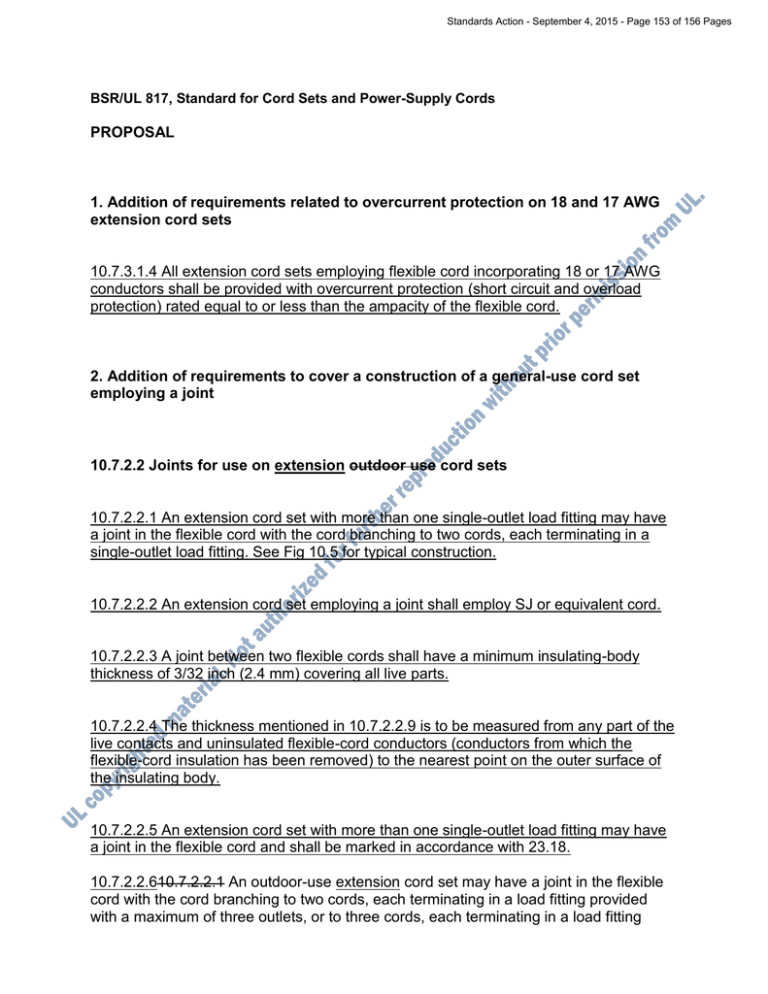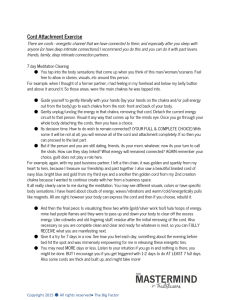PROPOSAL 1. Addition of requirements related to overcurrent
advertisement

Standards Action - September 4, 2015 - Page 153 of 156 Pages BSR/UL 817, Standard for Cord Sets and Power-Supply Cords PROPOSAL 1. Addition of requirements related to overcurrent protection on 18 and 17 AWG extension cord sets 10.7.3.1.4 All extension cord sets employing flexible cord incorporating 18 or 17 AWG conductors shall be provided with overcurrent protection (short circuit and overload protection) rated equal to or less than the ampacity of the flexible cord. 2. Addition of requirements to cover a construction of a general-use cord set employing a joint 10.7.2.2 Joints for use on extension outdoor use cord sets 10.7.2.2.1 An extension cord set with more than one single-outlet load fitting may have a joint in the flexible cord with the cord branching to two cords, each terminating in a single-outlet load fitting. See Fig 10.5 for typical construction. 10.7.2.2.2 An extension cord set employing a joint shall employ SJ or equivalent cord. 10.7.2.2.3 A joint between two flexible cords shall have a minimum insulating-body thickness of 3/32 inch (2.4 mm) covering all live parts. 10.7.2.2.4 The thickness mentioned in 10.7.2.2.9 is to be measured from any part of the live contacts and uninsulated flexible-cord conductors (conductors from which the flexible-cord insulation has been removed) to the nearest point on the outer surface of the insulating body. 10.7.2.2.5 An extension cord set with more than one single-outlet load fitting may have a joint in the flexible cord and shall be marked in accordance with 23.18. 10.7.2.2.610.7.2.2.1 An outdoor-use extension cord set may have a joint in the flexible cord with the cord branching to two cords, each terminating in a load fitting provided with a maximum of three outlets, or to three cords, each terminating in a load fitting Standards Action - September 4, 2015 - Page 154 of 156 Pages provided with a maximum of two outlets. In either case, the total number of outlets provided on the cord set shall not be more than six. 10.7.2.2.710.7.2.2.2 The resistance of the joint insulation to sunlight and mechanical abuse for outdoor use extension cord sets shall be at least equal to that of the interconnecting flexible cord. Molded-on joint insulation shall be compatible with the material used in the jacket of the flexible cord and shall adhere tightly to the jacket so as to exclude moisture. 10.7.2.2.810.7.2.2.3 A joint between two flexible cords in an outdoor-use extension cord set shall have a minimum insulating-body thickness of 3/32 inch (2.4 mm) covering all live parts. 10.7.2.2.910.7.2.2.4 The thickness mentioned in 10.7.2.2.3 is to be measured from any part of the live contacts and uninsulated flexible-cord conductors (conductors from which the flexible-cord insulation has been removed) to the nearest point on the outer surface of the insulating body. 10.7.2.2.1010.7.2.2.5 Insulation of neoprene, polyvinyl chloride, or butyl rubber is acceptable provided its adhesion to the cord jacket complies with 11.11. Joint insulation of other material may be investigated to determine its acceptability. 10.7.2.2.1110.7.2.2.6 The overall length of a cord set with a joint shall be determined from the sum of the lengths of the main cord (from plug to joint) plus the longest length of flexible cord from the joint to the cord connector. 21.1.11 A general-use cord set employing in-line cord connectors (see 10.7.2.1.13) or a joint (see 10.7.2.2.1) shall be marked on a tag permanently attached to the cord set, with the following or equivalent wording following the word "WARNING": a) "WARNING - To reduce the risk of electric shock, this product is for indoor use only. Not for use on construction sites or other similar locations." Alternately, this marking may be added to the marking tag in 21.3.1, and b) Within 3 inches (76 mm) of each cord connector: "WARNING - To reduce the risk of fire, the total amperes drawn from all the cord connectors shall not exceed ____ Amps". The blank shall be filled in with the maximum current rating of the outdoorgeneral-use cord set. Lettering shall be a minimum of 1/16 inch (1.6 mm) high. The markings and tags shall comply with the permanence requirements of 21.3.1.
